
by Sentimenti Team | Feb 12, 2023 | Sentimenti research
This is entirely human behavior. Most of us avoid painful emotions and suppress and hide them from the world. Suppressing our emotions is a common coping mechanism for dealing with difficult issues in everyday life. However, avoiding confrontation or pain (as long as we are talking about negative experiences) can harm our mental and physical health.
- Emotional suppression is the act of consciously or unconsciously blocking, suppressing or ignoring one’s emotions;
- Suppressing emotions can be a coping mechanism for dealing with difficult situations, or it can be a learned behavior based on past experiences;
- Regularly hiding one’s feelings can have negative consequences for mental as well as physical health;
- Crying is a normal and healthy way of expressing emotions, which serves to release accumulated emotions, reduce stress and improve well-being;
- Expressing one’s feelings improves emotional coping skills. It can also lead to improved communication with others and thus improve relationships with those around you.
Suppressing emotions. Why do we do it?
Emotional suppression can begin in early childhood due to various factors. The style with which our parents raised us may be behind it, but also family environments and life experiences. Here are some causes and examples of emotional suppression:
- Children who grow up in environments where expressing emotions is frowned upon (the belief that “big boys don’t cry”) may learn that feelings are something shameful and should not be openly expressed.
- Children can learn to suppress their feelings if they are exposed to role models who suppress their emotions.
- Children who have experienced traumatic events may suppress their emotions. This is a way to avoid re-experiencing traumatic memories.
Commonly suppressed emotions
Expressing one’s feelings can put a person in a confrontational situation or make them feel vulnerable. People find it easier to shut down and avoid dealing with conflict than to face the problem head-on. People most often suppress the following emotions:
- Anger. One of the most commonly suppressed emotions, as expressing anger is often seen as socially unacceptable, and people may suppress it as a way to avoid conflict or potential negative consequences;
- Sadness and grief. People may suppress these emotions because they find them difficult to deal with;
- Fear. It is often suppressed because of unwillingness to confront our fears;
- Guilt. People may feel guilty for something they did or didn’t do and don’t want to admit it.

People who suppress their own feelings often later have difficulty naming what they actually feel or making more sense of the phenomenon.
Recognizing suppressed feelings
People who suppress their feelings often have difficulty naming what they feel or making sense of it. Not being able to talk about what you’re feeling makes communication more difficult, but it also makes it harder to know which parts of your life are not fulfilling. Here are some signs that may indicate that we are more or less consciously suppressing our own emotions:
- People tell us that we are emotionally detached from reality;
- We experience high nervousness and anxiety;
- We avoid people when they say they are expressing their pain or sadness;
- We find it difficult to say “NO” or set boundaries, which can be an indicator of repressed anger and resentment;
- We become volatile and have emotional outbursts, such as crying or anger, whose intensity is disproportionate to the situation at hand;
- Physical symptoms such as tension headaches, muscle aches, fatigue and sleep disturbances appear;
- We have difficulty maintaining intimate relationships;
- We engage in self-destructive behaviors such as substance abuse, eating disorders, self-harm or other harmful coping mechanisms;
- We don’t like to be alone with our thoughts.
Crying? A normal and necessary phenomenon
Suppressing emotions is not always bad. In certain situations, it can be a healthy coping mechanism. Suppressing emotions can help one stay calm and think clearly when one is in a dangerous or potentially harmful situation. In some cultures, expressing certain emotions may be considered taboo, so suppressing them may be necessary to maintain social harmony.
Crying is a normal and healthy way to show how we feel, and can be good for mental and physical health. Crying brings us closer to people, allowing us to feel more empathy and receive more support from those around us. In addition, crying can help release accumulated emotions, reduce feelings of stress and anxiety, and improve overall mood.
Crying releases the stress hormone (cortisol) and the mood-regulating hormone (oxytocin). It also helps reduce feelings of sadness, anger and frustration.
Some people find it very difficult to cry, but that doesn’t mean they are incapable of feeling emotions. In addition, crying is not the only way to express emotions; other methods, such as talking, writing, art or exercising at the gym, can also be very effective.
What keeps us from crying?
There may be several reasons why someone may be afraid to cry:
- Socialization. Some people may have been taught during adolescence that crying is a sign of weakness or is unacceptable to their gender.
- Past trauma. Someone who has experienced traumatic events may associate crying with that trauma and may avoid crying to prevent reliving those memories.
- Fear of vulnerability. Crying can make someone feel vulnerable and exposed, and they may fear being judged or rejected by others.
- Fear of losing control. Crying can be an intense emotional experience, and some people may fear losing control when they cry.
Suppression of emotions and healthy ways to express emotions
- Conversation. Let’s share our feelings with someone we trust and who will listen to us without judgment;
- Let’s write about our emotions. Keeping a blog or diary is a great way to express your emotions and understand them better;
- Let’s engage in creative activities outside the home. Art, dance, music and writing are great ways to express emotions in a non-verbal way;
- Let’s exercise! Physical activity is a great way to release accumulated emotions and can help improve mood;
- Let’s practice mindfulness. Deep breathing, meditation and yoga can help you stay present in the moment and deal with your emotions more effectively;
- Seek professional help. Consider talking to a therapist or counselor to help understand and process emotions;
- Let’s practice self-compassion. When we feel emotions, let’s treat ourselves with kindness and understanding;;
- Let’s accept our emotions with kindness. Let us regularly ask ourselves: “What are you feeling right now?” Let us allow ourselves to fully experience and feel emotions without judgment.
Expressing your emotions can lead to personal growth and self-awareness. By acknowledging and expressing emotions, one can better understand oneself and one’s needs. Expressing emotions can be verbal or non-verbal, through art, music, writing or physical activity.
It can be worked through alone or together with other people. Everyone has to find their own way, which works best. Healthy disclosure of one’s emotions to the world, however, can take time and practice.

by Sentimenti Team | Feb 3, 2023 | Market research, Politics and Social
Disinformation – a word that appears in the public space every day. Russia almost every day conducts an intensive disinformation campaign against not only Ukraine, but also Poland and countries that help Ukraine, both militarily and humanitarian. Every day we face a séance of hostility, but above all a flood of lies about us.
Disinformation and pro-Russian narrative on X (formerly known as Twitter). What is being written about?
Analysts and specialists in disinformation and cybersecurity agree here. The purpose of the online campaign, which has been ongoing since the beginning of Russia’s invasion of Ukraine, is primarily to provoke hostility and antagonize Ukrainians and Poles. With each month of the war in Ukraine, the scale of the attacks intensifies, and increasingly harsh accusations and threats are made against Poland.
According to Stanislaw Zharyn, who has recently been acting as the government’s plenipotentiary for the security of Poland’s information space, Russia is actively conducting a psychological operation against Poland and the West as a whole. The operation is aimed at intimidating and forcing submission to Russian imperialism.
Russian propaganda is constantly conducting online operations aimed also at intimidating Poles. On the Internet, all themes appearing in Russia’s popular propaganda programs are being expanded. We decided to check what kind of content is created by the most popular Twitter accounts known for sowing disinformation, fake news about the war and – generally speaking – for their love of Russia.
We selected the 5,000 most popular posts (with the highest number of accumulated interactions) posted to this channel from each of the months between January 2022 and January 2023, i.e. for a full 13 months. A total of 494 profiles were manually monitored. The data collected in this way was further examined for emotion and sentiment, and we further examined which threads and thematic contexts aroused extreme emotion and generated high emotional arousal.
Among the online personalities we surveyed are mostly anonymous accounts and profiles, which often make typical Russian mistakes. They are created in part by transferring Russian content to Poland using automated free translation programs. Unfortunately, more influential people are increasingly included, spreading pro-Kremlin propaganda as a whole.
Festival of fake news and disinformation brings results
The incentive and starting point for our analysis was an article that appeared on gazetaprawna.pl (Polish). As we read in the material, titled “The Russian propaganda. “Poles increasingly susceptible to Russian propaganda [SURVEY],” recently there has been a strong increase in the number of people who more or less consciously share the theses circulated on the web that are part of pro-Russian disinformation. The Warsaw Enterprise Institute conducted its survey in this regard.
The results of the aforementioned survey show the same thing we see in the data we collected. Contexts of Ukrainian refugees, who are referred to as economic migrants, appear regularly. Even more frequent references are made to history, namely Volhynia and Bandera. Propaganda penetrates from Russia to Poland without any barriers via social media, but not only.
Returning to the 494 X (formerly known as Twitter) profiles we took under our magnifying glass, one thing strikes the eye above all. This is the extremely high level of activity. Some of the Twitter accounts are active to such an extent that it raises serious doubts about whether there are actually people behind them.
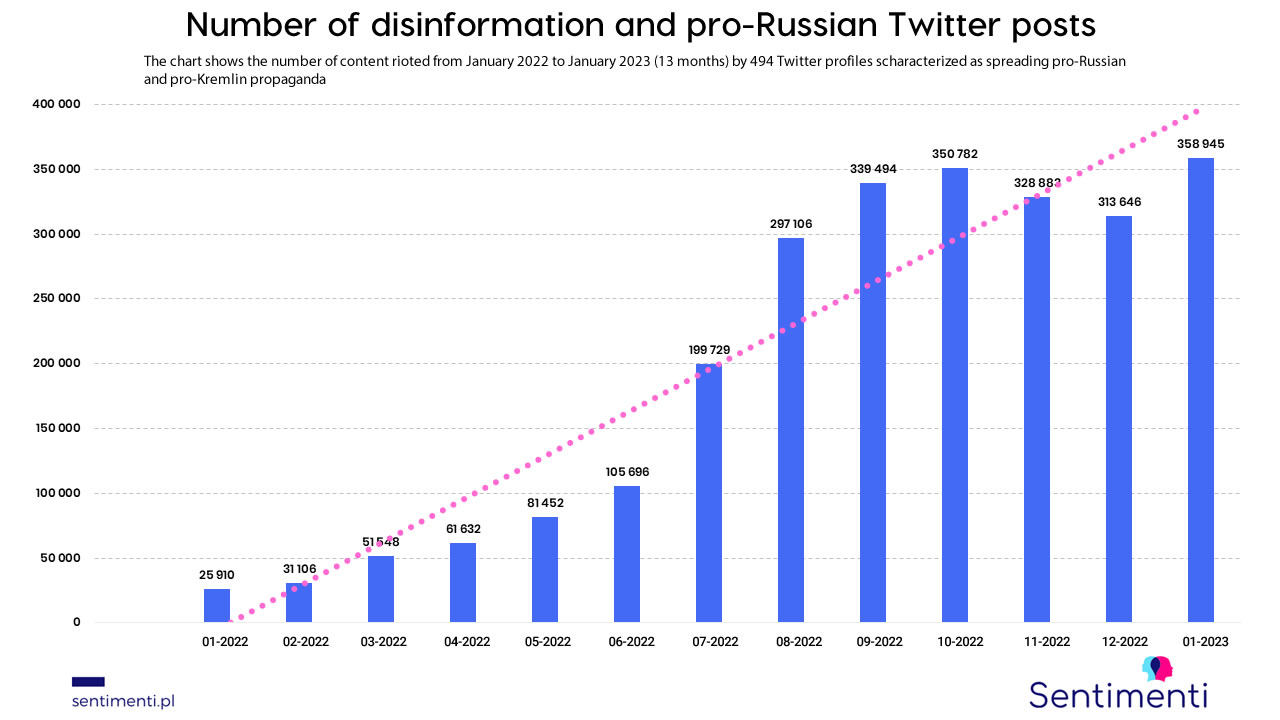
The Polish Anti-War Movement and the disturbing results of public opinion polls
The content is mass-collected in such quantities (200 or more posts a day) that it is challenging to imagine that the people behind it have anything else going on in their lives. There are also accounts that can flood a social network with several thousand pieces of content in a month. As for month-on-month increases in activity, for some periods the activity even increased by more than 80%. The trend is also noticeable and unambiguous.
What can be seen in the chart is, of course, only a slice of what is actually happening online. The point, however, is that this type of activity brings tangible results to those who conduct such a campaign online (increasingly, they also conduct it offline, i.e., on the streets of Polish cities).
The conclusions of the WEI study, as reported in Gazeta Prawna, are clear. In September 2022 and January 2023, the survey was conducted on 1,061 Poles. A comparison of the collected information yielded grim conclusions. , In January this year, as many as 41 percent of respondents (previously it was 34 percent) “strongly agreed” or “tended to agree” with a minimum of four statements characteristic of the Russian narrative
The opinions of Poles in this survey are very consistent with what narrative is served to them online, among other things. For 63 percent, Poland cannot afford to take in refugees. 41 percent are also convinced that refugees from Ukraine are economic migrants. 30 percent of Poles believe that we should not help Ukraine unless they apologize for the difficult history of relations between Ukraine and Poland. The group of Poles who believe that Russia should not be teased because it is a nuclear superpower has increased to 40 percent.
Content colluded by pro-Russian profiles online. What kind of sentiment?
Pro-Kremlin propaganda is beginning to increasingly shape what is going on in the minds of Poles. Declining support for supporting Ukraine or welcoming Ukrainians fleeing the war is a phenomenon that is occurring in parallel with what is happening to our economy.
Poles are increasingly connecting the dots and believe that the war is to blame for the fact that we have less and less in our wallets. This thesis is also being used in the narratives being spread.
The chart below is an analysis of the content we’ve gathered from nearly 500 profiles that colportage constantly pro-Kremlin content on X (formerly known as Twitter). Sentiment averaged negative on a monthly basis throughout the period analyzed, which is not surprising
However, not much variation in sentiment was noted for the entire 13-month period under study. What is clear, however, is how the narrative changed after the start of the war in February 2022, and that there was a marked jump in negative intensity.
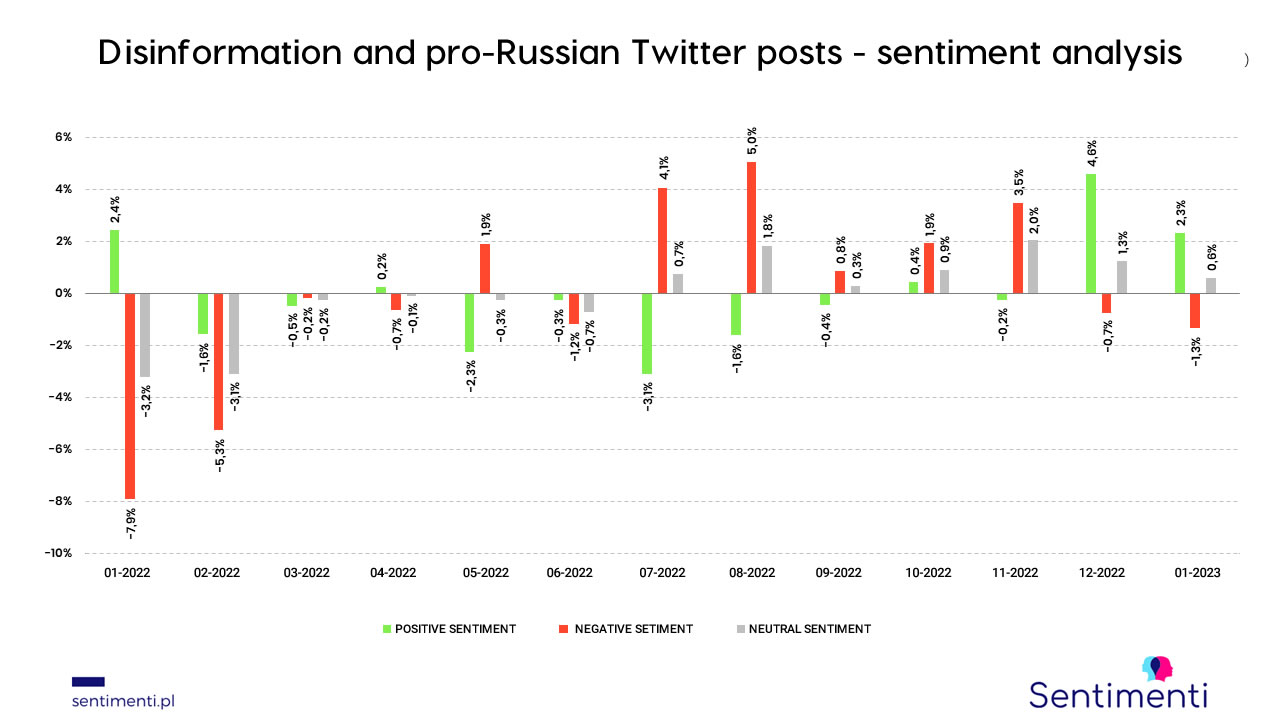
Contexts and topics covered by disinformation accounts
When it comes to the content of posts uploaded to the web, we checked the ones that carry the greatest emotional charge. It’s all about anger or revulsion. The following analysis is the result of this. The different colors denote groups of topics. The color black identifies political topics. The red color is in contexts related to the war in Ukraine and derivative topics such as the Volyn slaughter, genocide and the military.
The yellow color refers to issues related to refugees from Ukraine. Blue tinges the topics related to energy and climate policy and raw materials. We were also able to isolate issues related to coronavirus, which we marked in green.

The analysis shows perfectly what the analyzed profiles are colporting. We can see what the intensity is in terms of topics and what issues are being covered. These accounts produce intensely content hitting the Polish government. They are also spreading disinformation in the field of health care or pandemics. We also see the topic of Ukrainian refugees and the impact of their presence in Poland on our economic situation.
Russian trolls will be colporteurizing more and more such information in the near future, as indicated, for example, by the first chart in this article. Soon we should expect – in connection with the planned and long-announced spring offensive – more uploads, but with strictly military topics (including mobilization in Poland, which is not present).
One can expect a difficult time ahead. It will be difficult to distinguish truth from lies, but the goal is invariably the same – to divide Poles and Ukrainians, Putin’s strategic goal.

by Sentimenti Team | Nov 22, 2022 | Categorising comments, Market research, SentiBrand
As a strategic global partner of Statista®, we regularly study industries. We publish the results in the form of periodic reports or as requested by the client. They are of great interest among the surveyed companies, as well as their customers.

We have prepared a commercial report analyzing the intensity of emotions evoked among service users by the activities of Polish mobile operators in the period from January 2022.
What you will learn from the report:
- how my company compares to the competition,
- which services cause the most irritation and anger,
- which services your customers love,
- analysis of specific comments for each emotion.
Who was written about the most
The study examined more than 250,000 Polish-language comments and opinions found on the profiles of Play, Orange, T-Mobile, Plus, Nju Mobile, Lajt Mobile, Mobile Vikings and Virgin Mobile. They were posted on Facebook from January 2022.
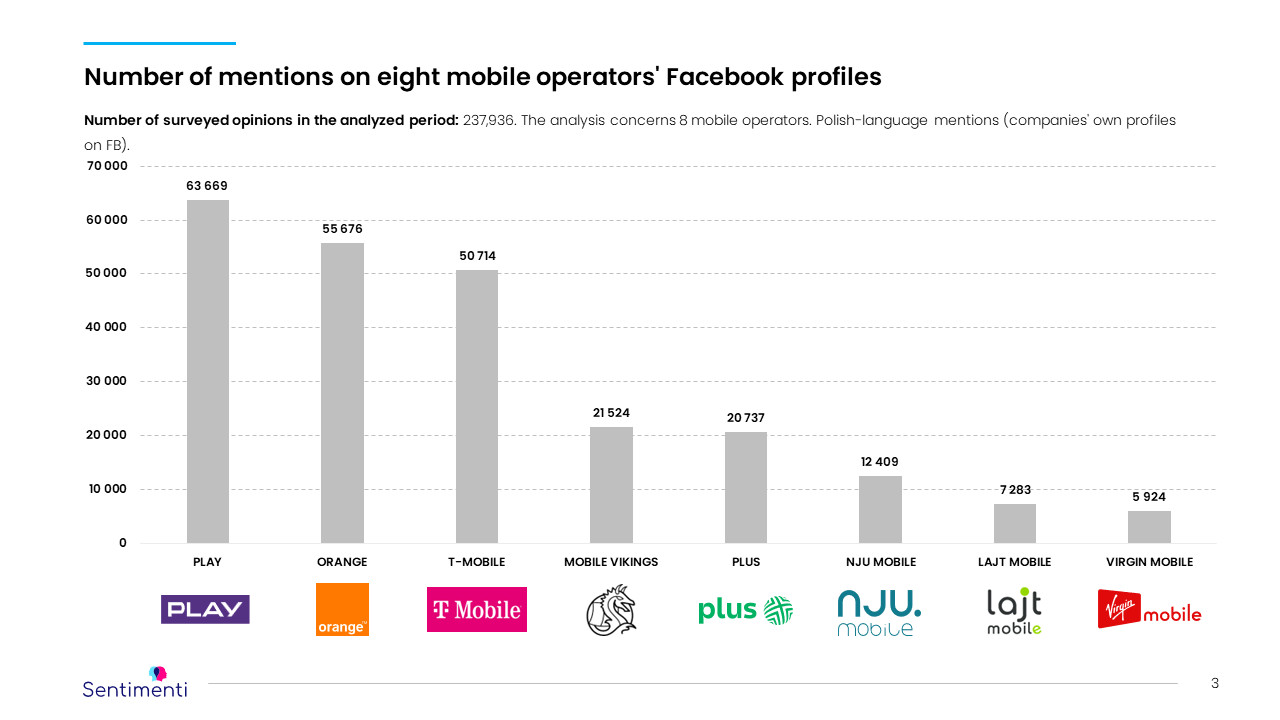
For starters – the sentiment
The chart shows the differences in the intensity of negative sentiment, positive sentiment and emotional arousal of an operator compared to the other seven companies. In other words, for example, the negative sentiment around operator 1 was 52% higher than the average sentiment measured for the other seven operators combined.
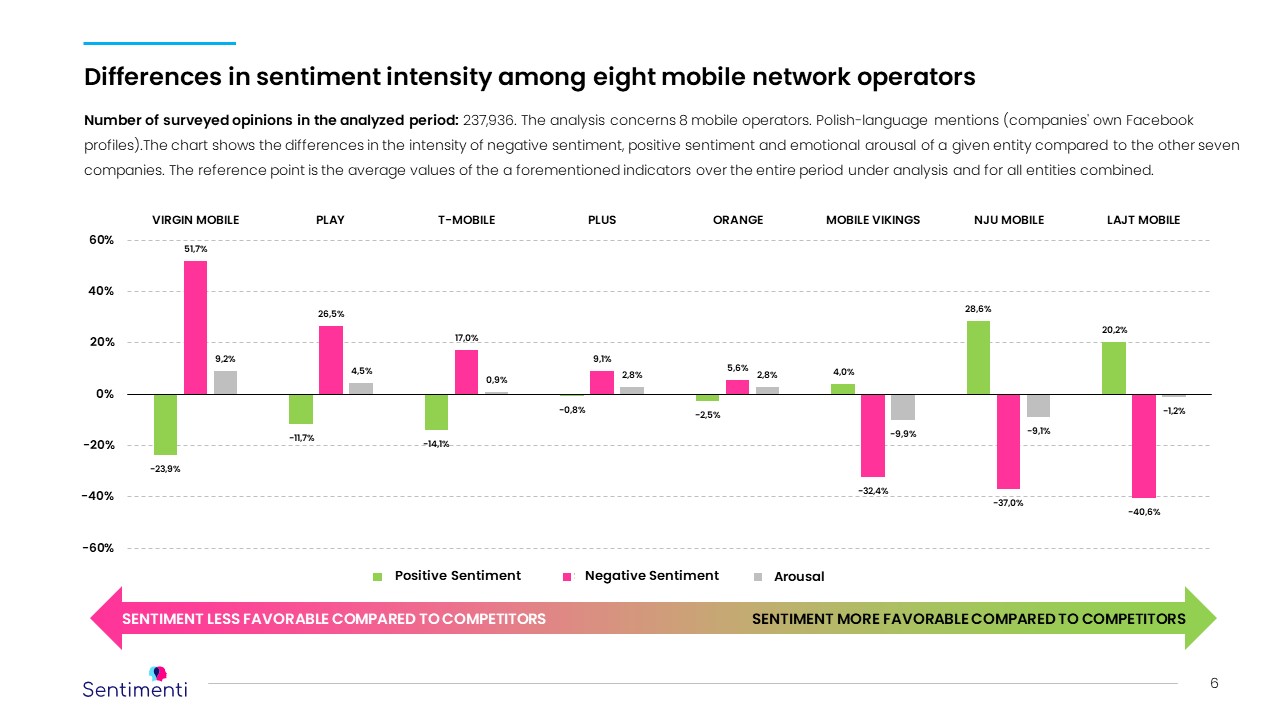
In this presentation, operators’ data have been anonymized (full data are available in the commercial report).
Emotions are more important
The chart shows the differences in the intensities of the selected four emotions in the discussion on a given company’s profile compared to the other seven. That is, similar to sentiment, for example, the intensity of the emotion of anger measured for operator 1 was 39% higher than the average intensity of this emotion measured for the other seven operators combined.
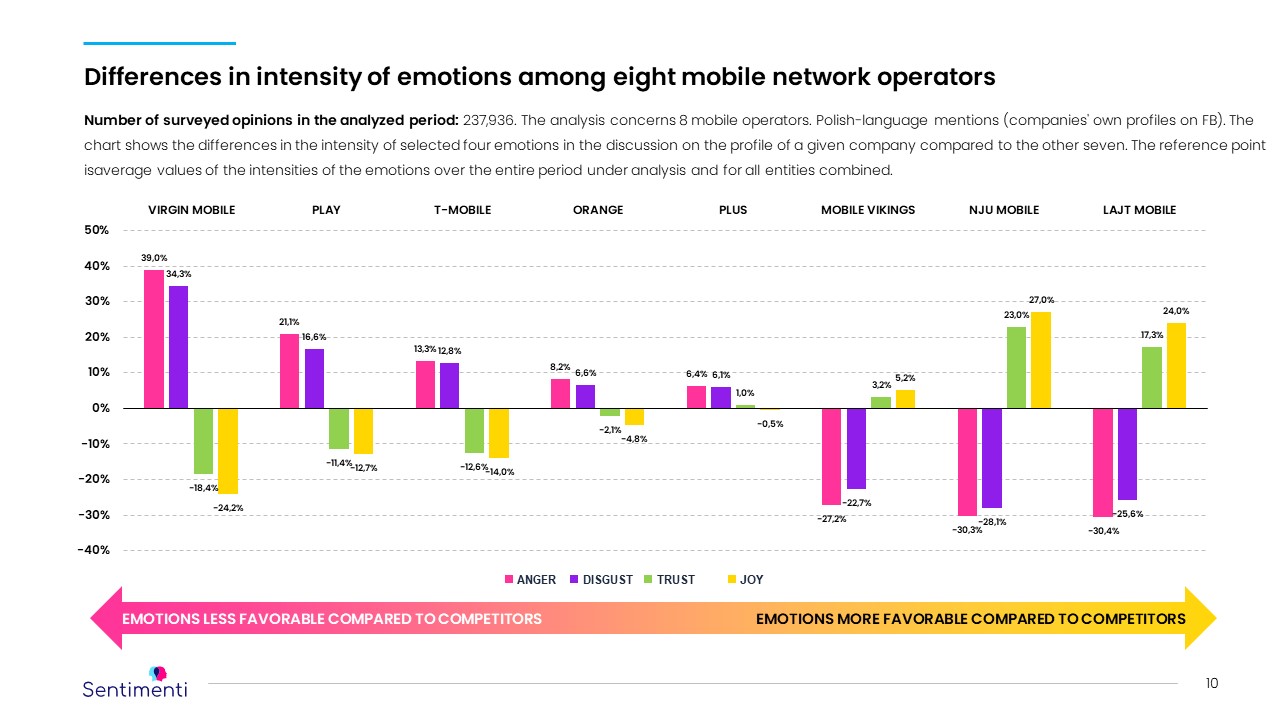
In this presentation, operators’ data have been anonymized (full data are available in the commercial report).
What else you can find in the report
The analyses indicated above are only a small part of the report. It further includes:
- analysis of the total number of mentions,
- analysis of the average intensity of sentiment and arousal for each operator,
- analysis of the average intensity of basic emotions for each operator,
- an analysis of mentions broken down into operator comments and Internet user comments,
- analysis of sentiment and arousal for operator and Internet user comments,
- analysis of contexts and themes in opinion content by emotion (e.g., anger and joy), separately for each operator.
- the most prominent comments in terms of stimulated emotions.
20221101_polish_telekoms_v3_EN
Use our information to improve communication with your customers and improve your service. We can update reports at any set period (even daily).
Our analysts will help you interpret the data so that you get the most out of the information that is important to you and your company…. Get back to us!












